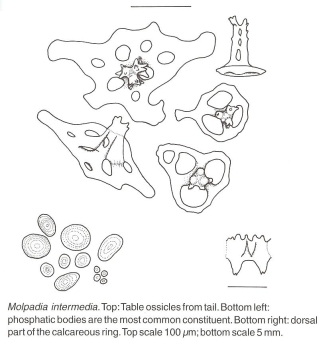intermedia = may mean intermediate
|
I have found no studies on the feeding habits of Molpadia intermedia. However, a similar species from the east coast, Molpadia oolitica, occurs vertically in the mud with its mouth pointing downward and its anus at the surface. Mud is eaten and forcibly expelled through the anus, forming a cone-shaped mound. M. intermedia may behave in a similar fashion.
Molpadia intermedia spawns from mid November to late December. Under study in a laboratory, females forcibly ejected negatively buoyant, orange-pink eggs of mean diameter at 267 μm from the gonopore at the anterior end. Males eject puffs of sperm over a period of 1.5 to 3 hours. The pelagic lecithotrophic larva settles out of the plankton after about 96 hours. In the laboratory, they are negatively phototactic. Early juveniles feed in the top few millimetres of mud with the mouth facing up.
The skin of M. intermedia is characterized by ovoid, reddish-brown granules made of some calcium and silica, but mostly a form of iron called ferric phosphate: hence the name phosphatic bodies. The granule content increases with age, and large specimens from shallow water have more. Researchers are not certain of the function of these granules.
The Sand Star (Luidia foliolata) preys on Molpadia intermedia.
|
|
